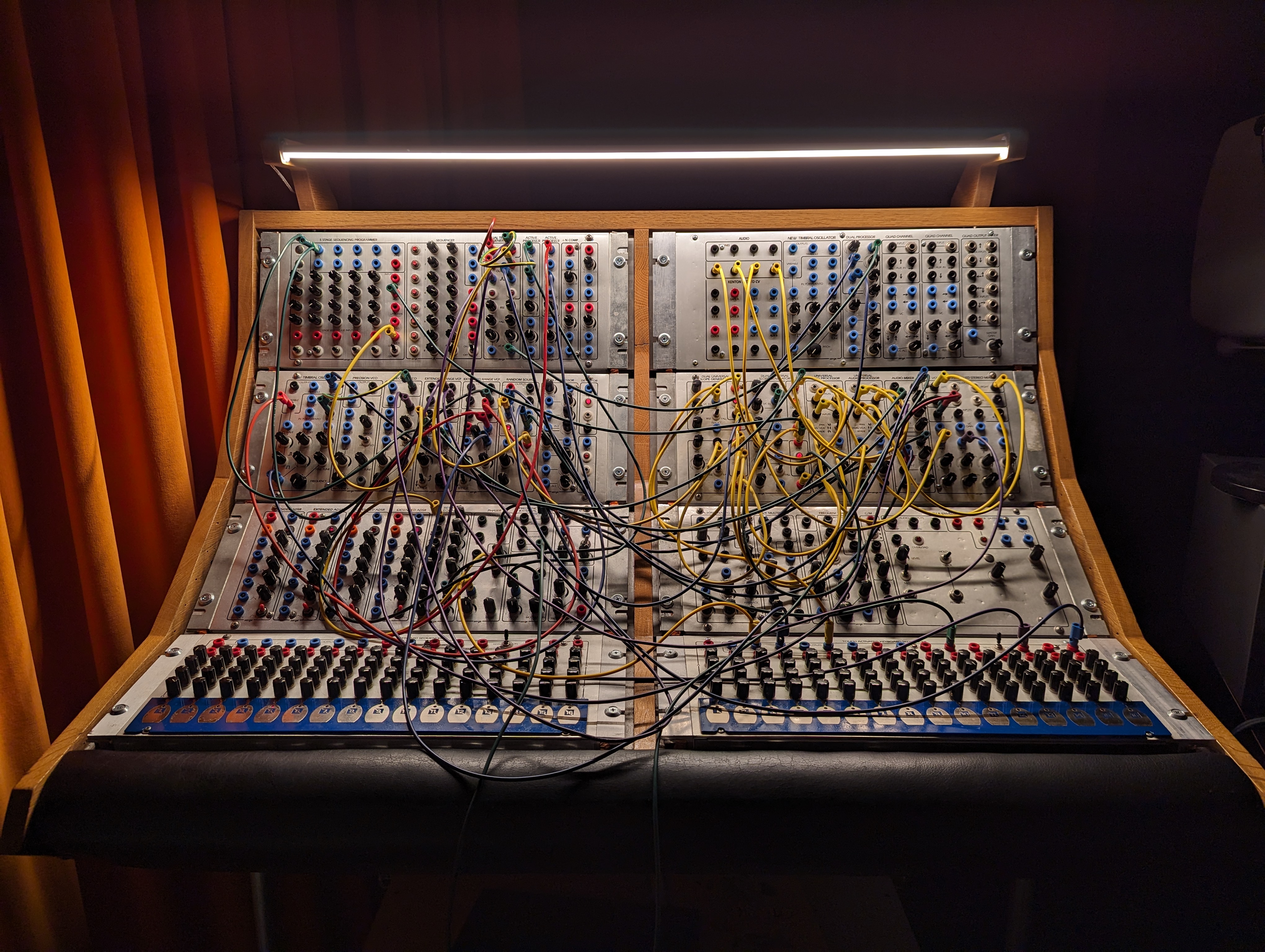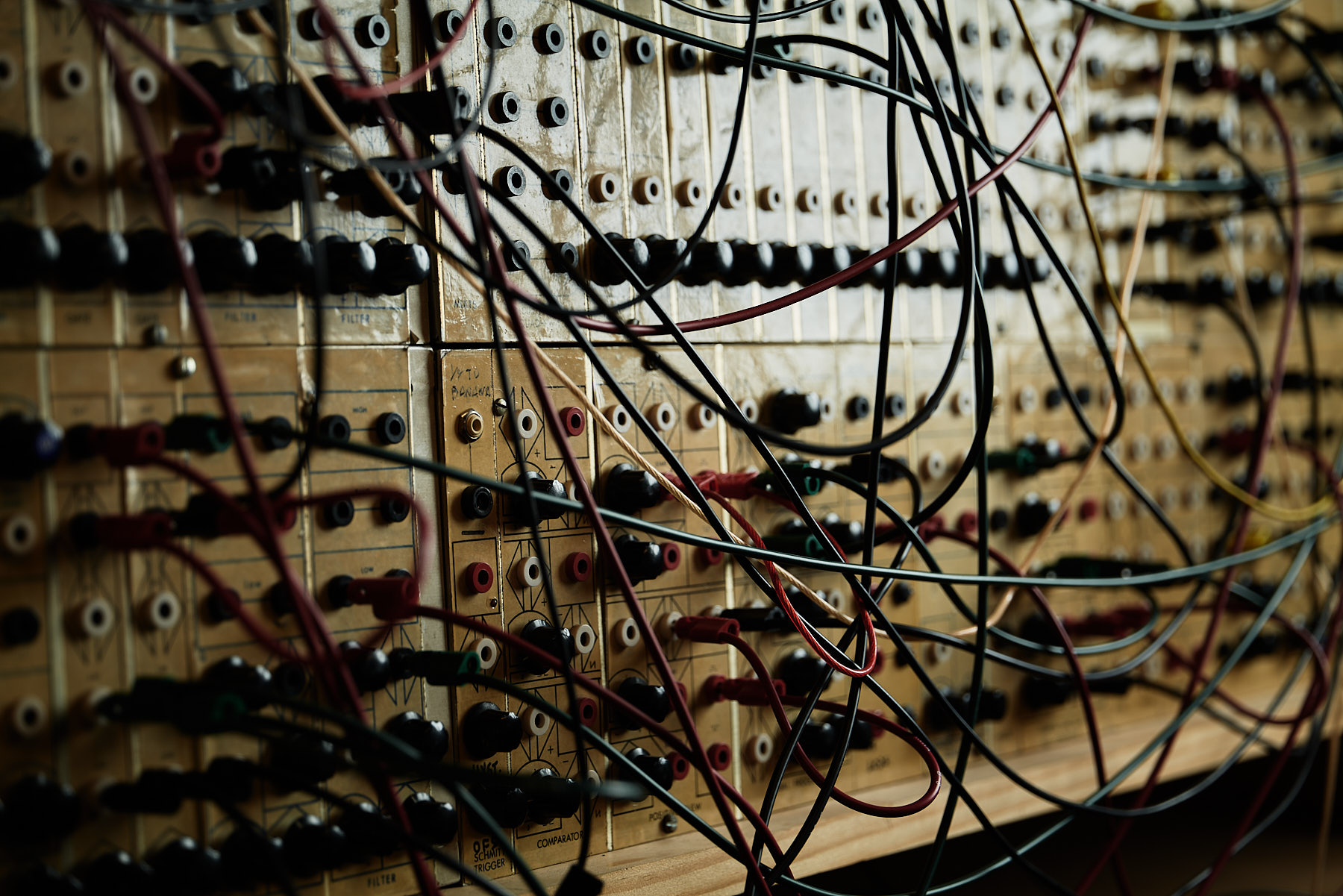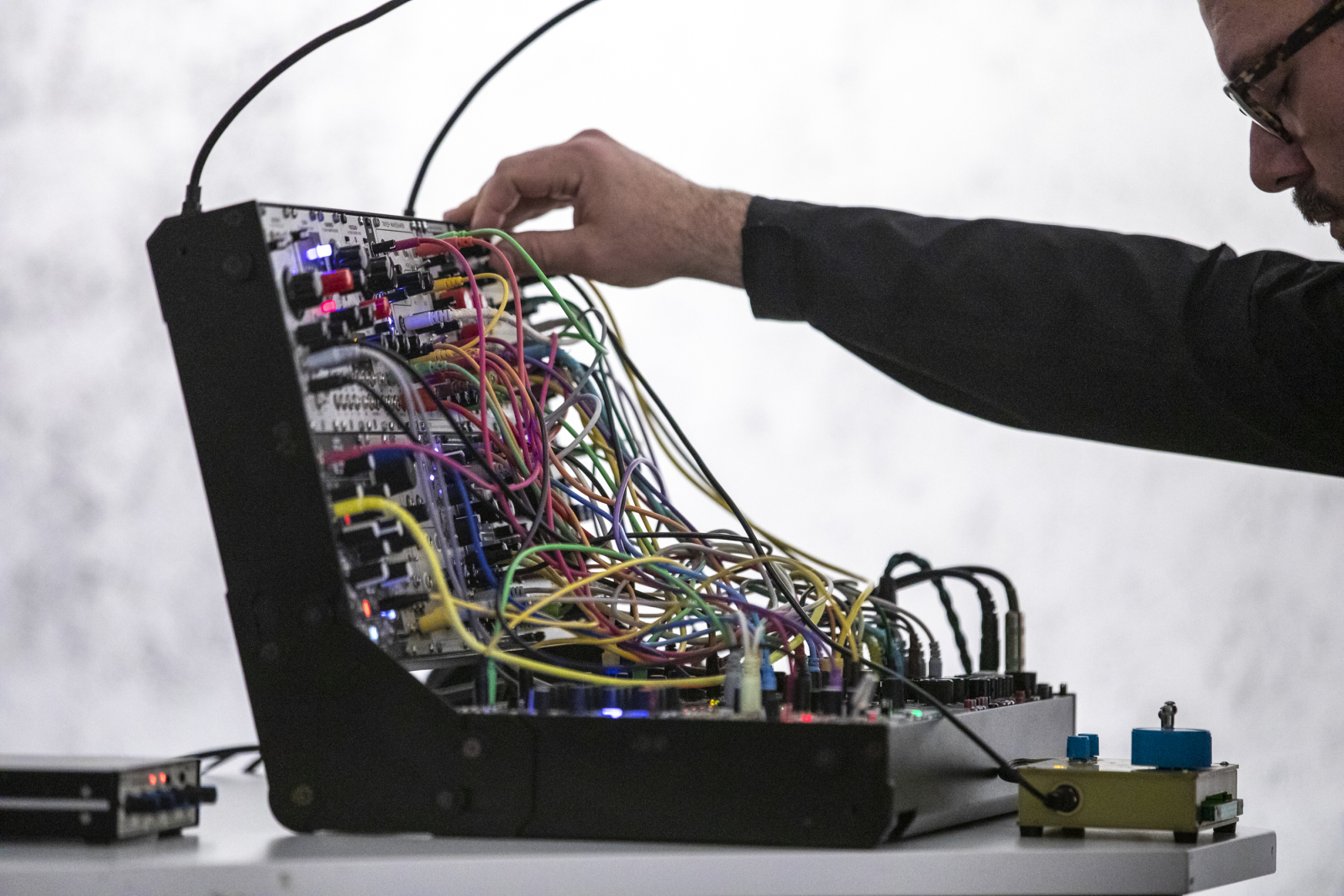7 August 2023
Metastable Structures: Composing for and with the Modular Synthesiser
 Image: Ben Carey
Image: Ben Carey © Kristoffer Paulsen
metastability:
- an unstable but potentially long-lived state of a system; for example, a supersaturated solution or an excited atom.
-
a physical system is said to be in
metastable equilibrium (or false equilibrium) when the
least modification to the parameters of the system (pressure,
temperature, etc.) is sufficient to break the equilibrium of
the system - Gilbert Simondon
metastable
/ (ˌmɛtəˈsteɪbəl) physics/
adjective
-
(of a body or system) having a state of apparent equilibrium although capable of changing to a more stable state
-
(of an atom, molecule, ion, or atomic nucleus) existing in an excited state with a relatively long lifetime
How does one give a name to an artistic project? For me, naming my projects is often the final step in my artistic process. As a composer and improviser of electronic music, I'm not trying to say anything with my work. I don't set out to create works with a grand plan, or extramusical stimulus guiding my compositional decisions. As such, I rarely name a project in advance, because the form of each is emergent, with the work representing the endpoint of a continuous negotiation between myself and a set of unwieldy and complex machines. However, recently I've been noticing that finding titles for my works is one of most intuitive parts of the creative process. These titles often arrive unannounced, and only after probing their meaning do I find how they relate to my work, and more importantly, its process of creation. METASTABILITY is one of these titles, a title given to my latest LP of music for Serge modular synthesiser, released in 2023 on Hospital Hill records, as well as the longest of its five tracks, and a live set performed at The Substation in 2022.

As my primary tool for composition and performance, the modular
synthesiser for me represents a site for human-machine dialogue,
exploration, and discovery. In essence, my works are crafted from
the interactivity between myself and the machines with which I
choose to interact. These systems inspire me because of the way
they make me think, and the questions they conjure about
instrumentalism, composition, and performance. Over the past
eight or so years, I have been performing and composing on
modular systems big and small, and diving deep into their
potential as the site for this musical questioning. Whilst I work
primarily on my own Eurorack system, I have been lucky enough to
explore some quite rare and historic machines, both in Australia
and elsewhere. METASTABILITY was composed on the colossal 1975 La
Trobe Serge Paperface modular synthesiser, housed at the
Melbourne Electronic Sound Studio (MESS Ltd). Over a period of
two four-day residencies, I dived deep into this rare and complex
machine, discovering historical approaches to modular synthesis,
as well as new musical horizons for myself. Most recently, I was
lucky enough to spend ten days as artist in residence at
Elektronmusikstudion (EMS) in Stockholm, Sweden, where I was
immersed in recording with some very rare systems designed by
Serge Tcherepnin and Donald Buchla, both early pioneers of
so-called 'west-coast' approach to analogue synthesis.
Click to play METASTABILITY:
Lately, I've been thinking of these systems not as musical instruments, but rather as composition and performance environments. In this way, I see them less as utilitarian tools for realising musical ideas, but as a fundamental part of my musical thinking process, and the site from which musical ideas emerge interactively. At its core, working with a modular system is about setting up an iterative process of musical decision making. Composing on a modular synthesiser is as much about building an instrument, like a luthier, as it is about creating new music. But whilst one might associate the practice of lutherie as linear, moving from engineered plans towards their designed endpoint, for me building an instrument with a modular system is an interactive process, borne of a negotiation between human intentions, and material agency.

To make music on a modular synth requires setting up a patch, a nest of connections between modules that determines the sonic and interactive potential of the machine. In my work with analogue synthesisers such as the Serge, this practice involves making many small decisions, decisions that are locally and internally consistent, not part of an over-arching schema, theme, or extra-musical idea. Making music with these systems involves a constant push and pull between nascent musical ideas, and the animacy of a machine in its operation. By engaging in a process, in my work I'm trying to respect the relationship between myself and instruments that are in a constant state of becoming. What this requires is a deep sense of trust; both in my ability for cumulative decision-making, but also in the integrity of this process to achieve something musically interesting.

In composing the music on METASTABILITY, and in my recent EMS residency, I focused on developing bespoke instruments that would push me in new creative directions. These historic systems, whilst capable of a vast array of musical possibilities, are also limited by the potential of the modules contained within them. On something like the Serge Paperface, each patch emerged organically, resulting in musical pathways and potential modes of engagement that were as fresh to me as they are to anyone listening to music for the first time. Pressing the red button to record an interaction, I felt myself exploring these spaces, not knowing exactly where they might lead, or what their eventual musical outcome might be.
In my work, I focus on making small, iterative decisions in response to the current conditions. However, what I am searching for are spaces in which the right decision is not so obvious, and if an obvious decision presents itself, I often choose to avoid it, opting for the path least trodden. I enjoy letting my interactions with these machines generate ideas, rather than imposing ideas on the process from the outside. Especially at the beginning of an interaction, my focus is on creating processes that, through their emergent complexity, present me with multiple possible options. Rather than opting for clarity, I set up processes that invite me to make my next move in the form of a question, rather than an obvious decision, a sort of what if? decision.
Ben Carey METASTABILITY (live at The Substation)
What energises me about this is the emergence of structures, sounds, and processes that I couldn't have designed from the outset. These grow, cumulatively with every decision, interaction, and observation of a process. As multiple small decisions accumulate, unforeseen states emerge that propose new musical pathways. Making a new decision requires listening and observing, and actively engaging with the processes, to find out their boundaries. Inherent in this practice is a sense of fragility, as well as the possibility of losing perspective, both in the midst of building up such processes, but also in coming back to them. Being in tune with the relationship between various moving parts, with an awareness of the controls that might shift elements of a process, sound, or structure, is a big part of working with modular systems. However, sometimes losing this sense of perspective can generate new pathways, initially undiscovered in an interaction.
I have begun to describe this aspect of my practice as one of emergence. It is a process in which my perception is as important as the underlying complexity of the patch itself. In this work, my decisions accumulate, creating chains of causal relations between various parts of a system or patch. What I find fascinating is how are series of simple, cumulative decisions tip over into a sense of emergent complexity. As a patch grows, these processes provide constantly shifting ways of understanding their relationships to each other. Simple processes (modulations, oscillations), when put into relation with other simple processes, can create complex shapes that are difficult to exactly predict in advance.

Thinking back on the recordings that went into METASTABILITY, I found this title an apt description of some of the states I discovered in working with the Serge, as well as the structural decisions I began to make whilst composing with material away from the instrument. By setting up multiple forms of controlled feedback, I would often arrive at more or less stable states, but those that could very easily tip over into a sense of chaos with the movement of a dial or switch. Even the slightest change could radically shift the direction of a musical interaction, tipping the system over from something metastable to something chaotic or unpredictable. The process was equally generative in working with the machine as it was in editing my recordings. By discovering these tipping points in my interactions with the Serge, I found myself trying to emulate these processes through montage and editing, juxtaposing stable musical materials with more chaotic forms, as well as layering various materials together to create textural density.
After a while working with these systems, one develops a certain amount of technique, just as with any musical instrument. However, what I'm always searching for are these ruptures where my technique is called into question, metastable states in which my idea of a patch could be radically shifted at the flip of a switch. It's this feeling of overwhelm, and the temporary loss of control and perspective that I find intensely satisfying as a composer and improviser, which is what keeps me returning to these systems again and again.
© Australian Music Centre (2023) — Permission must be obtained from the AMC if you wish to reproduce this article either online or in print.
Benjamin Carey is a Sydney-based composer, improviser and educator. He makes electronic music using the modular synthesiser, develops interactive music software and creates audio-visual works. Ben's research and practice is concerned with musical interactivity, generativity and the delicate dance between human and machine agencies in composition and performance.
Comments
Be the first to share add your thoughts and opinions in response to this article.
You must login to post a comment.